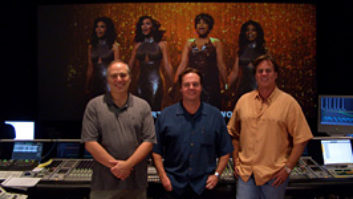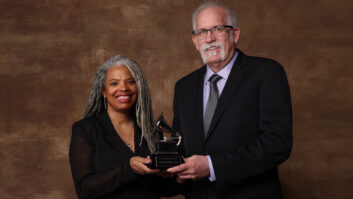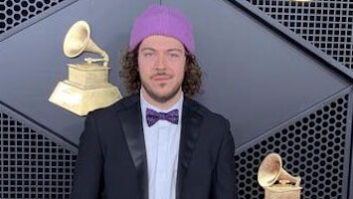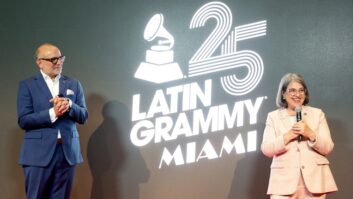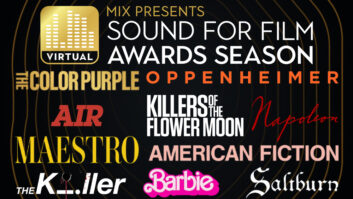A Salute to the Tech Winners
This is supposed to be the Age of Choice in the world of cable/satellite TV. So how come the first three hours of the Grammys, when 80% of the 100 are doled out, aren’t televised somewhere? Instead, those of us who care about more than the so-called “major” awards have to settle for half-second mentions of the “other” winners as they scroll across the screen on the way to a commercial break. Not much glory in that.
This is not to demean this year’s telecast from the Staples Center in Los Angeles. The show was nicely paced and ran smoothly. Jon Stewart of The Daily Show was a fine host — witty, without being too cynical — and there were a number of excellent performances, including Madonna’s typically flamboyant opening; the silky pop/R&B of Destiny’s Child (who looked like they were dressed for the Gammy Awards); U2’s inspiring and anthemic performance of the Record of the Year; the peculiar but soulful grouping of Moby, Jill Scott, Blue Man Group, a band and an orchestra; the over-hyped but actually quite moving Eminem/Elton John duet on “Stan”; and many others.
Below is a listing of the winners from Mix‘s world — producers and engineers, as well as a few words from three of this year’s honorees.
RECORD OF THE YEAR: “Beautiful Day,” U2
Produced by Daniel Lanois and Brian Eno. Engineered by Richard Rainey. Mixed by Steve Lillywhite.
Only this song from the group’s superb All That You Can’t Leave Behind album fell into the Grammy’s eligibility period. Otherwise, we might have seen Bono and Co. bounding up onto the stage for Album of the Year honors, too. (“Beautiful Day” was also Song of the Year and Best Rock Performance by a Group.) Will the album be forgotten next year? Not if U2’s upcoming tour of the U.S. keeps their name out front.
ALBUM OF THE YEAR: Two Against Nature, Steely Dan
Produced by Walter Becker and Donald Fagen. Engineered by Roger Nichols, Elliot Scheiner, Dave Russell and Phil Burnett.
Though Steely Dan albums have won technical awards in the past (see below), this year marked the first time Donald Fagen and Walter Becker have taken home trophies themselves, leading many to observe that perhaps this was more of a “career” award than a specific endorsement of their Two Against Nature comeback. The fact is, though, that the Steely Dan album was strong, tuneful and, as we’ve come to expect, impeccably recorded.
PRODUCER OF THE YEAR, NON-CLASSICAL: Dr. Dre
Dr. Dre has long been a formidable production force, and 2000 was certainly his year, between his own album, Dr. Dre: 2001; his work with Eminem, including “The Real Slim Shady” and “Bitch Please II”; NWA’s “Chin Check”; and Ice Cube’s “Hello.” Recording Academy president Michael Greene made a point of saluting Dr. Dre’s win in this category during his annual (and always entertaining) harangue during the telecast. Though Dre was naturally pleased by his Grammy victory, he was less than gracious about the Eminem CD’s loss to Steely Dan in the Best Album category: “To be perfectly honest, I think we were robbed,” he told an interviewer. At least the ballots weren’t counted in Florida.
BEST ENGINEERED ALBUM, NON-CLASSICAL: Two Against Nature, Steely Dan
Engineered by Roger Nichols, Elliot Scheiner, Dave Russell and Phil Burnett.
Winning Grammys never gets old — just ask Roger Nichols. The veteran engineer, who has been involved in the recording of every Steely Dan album, won his fifth Grammy at the Staples Center (the others were Steely Dan’s Aja in 1977, FM in ’78, Gaucho in ’81 and for a John Denver children’s disc called All Aboard in ’97). While hardly blasé about his victory, Nichols seems most excited that Becker and Fagen finally won the big prize. “I thought that we had a pretty good chance of winning the engineering Grammy,” he says, “but even with that, you never know. So when we won that I was happy. Then, when Donald and Walter started winning the other awards, I thought, ‘Oh, this is great, but I still bet the voters are going for Eminem for Album of the Year.’ I absolutely did not expect to get that award; it’s great!”
Sharing the award with Nichols is the ubiquitous Elliot Scheiner (a two-time winner for Aja, his first Steely Dan album, and Gaucho) and two relative unknowns: “Phil Burnett works for Donald in his studio, River Sound,” Nichols says. “He was working with me when we were doing the recording. Lots of times he’d be manning the board when we were doing vocal overdubs, or something, and I’d be manning the Pro Tools, so we were side by side. He put in as many hours as I did. And the same sort of thing was happening in Hawaii at Walter’s studio with Dave Russell. I’d do some overdubs and then Dave would work on them. We’d switch off — ‘The horns are coming in.’ ‘Okay, I’ll do them.’ ‘Donald’s doing some vocals; Phil you do that.’ I felt like they did as much as Elliot and I, so they deserved the recognition.”
The album, which was cut at Clinton in New York and Becker’s and Fagen’s studios, took 18 months to record, short by Steely Dan standards. Why does Nichols think the disc caught the fancy of the voters? “It’s real music. The songs are interesting, the lyrics are good…Steely Dan albums stand the test of time.”
REMIXER OF THE YEAR: Hex Hector
The New York-based remixer was honored for his mixes of Jennifer Lopez’ “Feelin’ So Good,” 98Þ’s “Give Me Just One Night,” Whitney Houston’s “I Learned From the Best,” Madonna’s “Music” and Toni Braxton’s “Spanish Guitar.”
BEST CLASSICAL ALBUM: Shostakovich: The String Quartets, Emerson String Quartet
Producers: Max Wilcox and Da-Hong Seetoo. Engineered by Wilcox, Seetoo and Nelson Wong.
Co-producer Wilcox has won two Grammys previously, for Classical Album of the Year in 1976 (Beethoven: The Five Concertos) and Best Opera Recording in 1983 (La Traviata). The internationally acclaimed Emerson String Quartet has won four previous Grammys. The CD was recorded live at Harris hall in Aspen, Colo.
PRODUCER OF THE YEAR, CLASSICAL: Steven Epstein
A seven-time Grammy winner (including Producer of the Year in ’84, ’95, ’97 and ’98), Epstein didn’t attend this year’s festivities. “I was up against some very strong competition, some wonderful producers, and, quite frankly, I wasn’t so sure it was going to be a winning year for me,” he says. “Honestly, it’s always a surprise to me, and a happy one.” Epstein notes that he was nominated “for a more eclectic group of recordings this year than usual,” which may have helped him.
Two were high-profile “crossover” projects: Appalachian Journey featured a diverse group of classical, pop and country players that included Yo-Yo Ma, Edgar Meyer, Mark O’Conner, James Taylor and Alison Krauss. It was recorded in Mechanics Hall in Worcester, Mass. (“My favorite venue for recording chamber music,” Epstein says.), using only a pair of B&K 4009 mics to DSD. Chick Corea’s Corea.Concerto brought together the jazz pianist’s regular sextet and a symphony orchestra at Air Studios in London.“The challenge there,” Epstein says, “was to combine two different approaches to recording: For the jazz group, you want to be in close, to capture the power of the individual instruments, whereas with the orchestra, you’re going for a more natural overall sound of the ensemble. The trick is to get the best of both elements.”
Other discs Epstein was honored for were Corigliano: Phantasmagoria, a collection of Dvorák pieces, and pianist Murray Perahia’s Song Without Words.
BEST ENGINEERED ALBUM, CLASSICAL: Dvorák: Requiem; Symphony No.9
Engineer: John Eargle.
This was the first win (after three previous nominations) for Eargle, who also didn’t attend the Grammys, “because I would’ve sat there like I was waiting for my own execution,” he says with a laugh. The CD features the renowned Czech conductor Zdenak Macal leading the New Jersey Symphony and the 140-voice Westminster Symphonic Choir through two of Dvorák’s best-loved pieces.
“Macal is certainly an expert when it comes to the music of his countrymen, such as Dvorák,” Eargle comments. “And the setting was great. It was recorded at the New Jersey Performing Arts Center in Newark, which is a beautiful new room with acoustics designed by Russell Johnson.
“We put our gear into the radio booth in the back of the hall. We had eight channels of 24-bit Apogee AD-8000. We monitored a complete stereo mix, but at the same time we had bused out the following pairs: the two mics that covered the soloists, the main mic pair and the house pair. [Mics included the Sennheiser MKH20, Sanken CU-41, Neumann KM84 and Neumann KM100 Series.] That gave us a certain amount of remix flexibility, and it meant that we have the ingredients for bringing it out in the future as a surround sound recording. In fact, all our orchestral pieces are being done that way now.” Mixing and editing were done at Delos International’s facility in L.A. using a Sonic Solutions system.
Blair Jackson is Mix’s executive editor.
